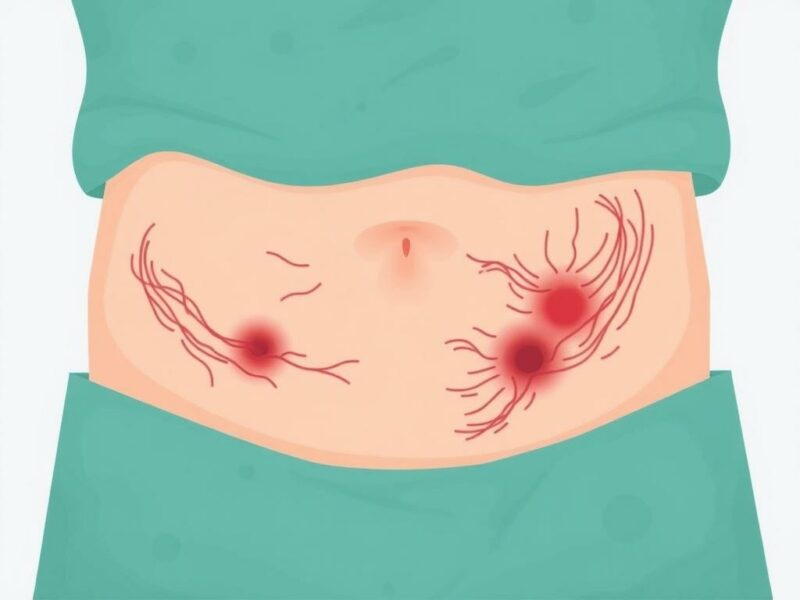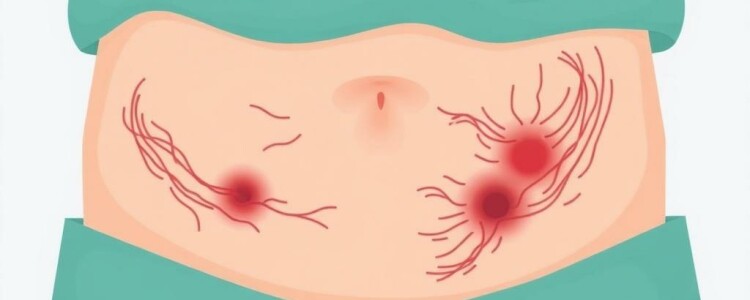Introduction to Appendectomy and Scarring
An appendectomy, the surgical removal of the appendix, is one of the most common emergency surgeries performed worldwide. Whether caused by appendicitis or other complications, this procedure can be life-saving. However, like all surgeries, appendectomy comes with its own set of after-effects, and one of the most noticeable is scarring. Scarring after appendectomy is a concern for many patients—not only because it marks the location of the surgery but also because it can impact confidence, comfort, and even skin health. Understanding why scarring occurs, what it looks like, and how to manage it effectively can make the recovery process much smoother and more reassuring.
Scarring is the body’s natural way of healing after injury or surgery. When the skin is cut during an appendectomy, the body works to repair the tissue, resulting in scar tissue formation. Not all scars are the same, and factors like the surgical technique, individual skin type, and post-surgery care play crucial roles in determining the final appearance of the scar. In this article, we’ll explore everything you need to know about scarring after appendectomy, including types of scars, healing timelines, prevention techniques, treatment options, and tips to care for your skin after surgery.
What Causes Scarring After Appendectomy?
The primary cause of scarring after appendectomy is the incision made to access the appendix. Traditionally, open appendectomies require an incision in the lower right abdomen, which can range from 2 to 4 inches long. More recently, laparoscopic appendectomy—a minimally invasive procedure—involves smaller incisions, generally about 0.5 to 1 cm each, which typically result in less noticeable scars.
The healing process itself triggers inflammation and the production of collagen, a protein that helps close wounds. However, excess collagen or improper healing can cause scars to become raised, thick, or discolored. Other factors influencing scarring include:
- Skin Type: People with darker skin tones or sensitive skin might experience hyperpigmentation or keloid scars.
- Age: Younger people tend to heal faster but may have more noticeable scars.
- Genetics: Some individuals are naturally prone to excessive scar formation or abnormal scars.
- Infection and Wound Care: Poor hygiene or infection can worsen scarring.
- Movement: Excessive movement or tension near the incision site can stretch the wound, leading to wider scars.
Difference Between Laparoscopic and Open Appendectomy Scars
| Feature | Open Appendectomy Scarring | Laparoscopic Appendectomy Scarring |
|---|---|---|
| Incision Size | 2-4 inches | 0.5-1 cm (usually three small incisions) |
| Scar Appearance | Single, longer scar | Multiple small scars |
| Healing Time | Longer, more healing required | Faster recovery |
| Visibility | More prominent | Less visible, often fades well |
Types of Scars You May Experience After Appendectomy
Not all scars look or feel the same. Depending on how the wound heals and your body’s reaction, you may notice different scar types after your appendectomy.
Normal Linear Scar
A well-healed, normal scar is usually thin, flat, and pale. It might be slightly lighter or darker than the surrounding skin but generally fades over time. This type is the most common and generally causes no pain or discomfort.
Hypertrophic Scar
Hypertrophic scars are raised, red, or pink and remain within the boundaries of the original incision. These scars may appear a few weeks after surgery and can become itchy or tender. They often improve over months to years but may require treatment if bothersome.
Keloid Scar
Keloids are thick, raised scars that extend beyond the original wound boundary. They are more common in people with darker skin and may continue growing. Keloids can be itchy and uncomfortable and are more challenging to treat.
Atrophic or Depressed Scar
Sometimes, the scar tissue can be sunken or depressed, which happens when the new tissue fails to fill the area properly. Although less common after appendectomy, this type can occur, especially if there is tissue loss or poor wound healing.
The Healing Timeline of Scars After Appendectomy
Knowing the stages of healing can set realistic expectations and help you identify any abnormal changes that need medical attention.
- First 1-2 Weeks: The incision closes and initial inflammation subsides. The tissue is fragile, so care must be taken to avoid reopening the wound.
- 1-3 Months: Collagen production increases; the scar may appear red or raised during this active healing phase.
- 3-6 Months: Collagen remodeling starts; the scar begins to flatten and fade in color.
- 6-12 Months: Scar maturation occurs; scars generally reach final appearance, although some change can happen after this period.
During this time, scars are sensitive to sunlight and physical stress, so protecting and caring for them is critical.
Preventing and Minimizing Scarring After Appendectomy

While some scarring is inevitable, there are several steps you can take to prevent excessive or problematic scars:
1. Follow Your Doctor’s Wound Care Instructions
Proper wound care is crucial. This includes keeping the incision clean, changing dressings as recommended, and avoiding soaking the wound in baths or swimming pools until fully healed.
2. Avoid Tension on the Incision
Excess stretching or pulling can widen scars. Avoid strenuous activity or movements that stress the abdominal muscles during the early weeks of healing.
3. Don’t Pick or Scratch the Scar
It may be tempting to touch or scratch the scar, especially if it itches, but this can cause irritation or infection, worsening the scar.
4. Protect the Scar from Sun Exposure
Ultraviolet rays can darken scars and make them more noticeable. Use a high-SPF sunscreen on the scar when exposed and cover it with clothing if possible.
5. Use Silicone Gel or Sheets
Silicone-based treatments are widely recommended to reduce scar thickness and discoloration. They create a protective barrier, maintaining hydration and optimizing healing.
6. Maintain a Healthy Diet and Hydration
Good nutrition supports skin repair. Foods rich in vitamins C and E, zinc, and protein can promote better healing outcomes.
Treatment Options for Scars After Appendectomy
If your scar is bothering you, there are multiple treatment options ranging from home remedies to clinical procedures.
| Treatment | Description | Effectiveness | When to Consider |
|---|---|---|---|
| Silicone Gel or Sheets | Topical treatment to hydrate and soften scar tissue | Effective for hypertrophic scars and fresh scars | Early after wound healing |
| Pressure Dressings | Apply constant pressure to reduce scar thickness | Useful for raised scars | Within months of scar formation |
| Corticosteroid Injections | Injection to reduce inflammation and scar size | Good for hypertrophic and keloid scars | When scars become raised and itchy |
| Laser Therapy | Laser treatments to resurface and flatten scars | Varies, often improves texture and color | After scar maturation (6 months+) |
| Surgical Revision | Removal or alteration of scar tissue by surgery | Usually last resort | Severe or functionally impairing scars |
| Microneedling | Skin needling to stimulate collagen remodeling | Effective for texture improvement | Several months post-healing |
Natural Remedies and Home Care
Some people prefer trying natural remedies, though these tend to have less robust scientific backing. Options include:
- Aloe Vera gel
- Coconut oil or vitamin E oil
- Honey-based treatments
If you choose to use these, be cautious and monitor for allergic reactions or irritation.
Emotional and Psychological Impact of Scarring
Scars after appendectomy can sometimes have effects beyond the physical. Especially when located on visible areas of the abdomen, scars may influence self-image and confidence. It’s normal to feel self-conscious or frustrated about lasting marks from surgery. Talking to healthcare providers about your concerns, joining support groups, or consulting specialists for scar treatments can be helpful in managing these feelings. Remember, scars are a symbol of healing and survival, and with time and care, they often become less noticeable.
Appendectomy Scarring in Children and Adolescents
Children tend to heal faster but may have different scarring tendencies compared to adults. Young skin is more elastic, but some children may develop raised scars or keloids, especially if there is a family history. Parents should ensure proper wound care, monitor healing closely, and consult pediatric surgeons if scarring seems abnormal.
Tips for Long-Term Scar Care and Maintenance
Even after the initial healing phase, ongoing care can help maintain a healthier scar appearance. Try incorporating these habits:
- Keep the area moisturized with gentle creams.
- Regularly protect the scar from harsh climate and sunlight.
- Massage the scar gently to improve circulation and reduce stiffness.
- Stay hydrated and maintain a balanced diet.
- Monitor for any changes in color, texture, or pain, and consult your doctor.
Conclusion
Scarring after appendectomy is a natural and common part of the surgical healing process. While scars are unavoidable to some extent, understanding their causes, types, and phases of healing empowers you to take proactive steps to minimize and manage them effectively. Whether you had an open or laparoscopic appendectomy, proper wound care, sun protection, and timely treatment can significantly improve the appearance of your scar and help avoid complications like hypertrophic or keloid scarring. If scars become a source of discomfort or concern, numerous medical and cosmetic options are available to support you. Most importantly, remember that every scar tells a story of resilience and recovery—a mark of your body’s incredible ability to heal and keep you healthy.



